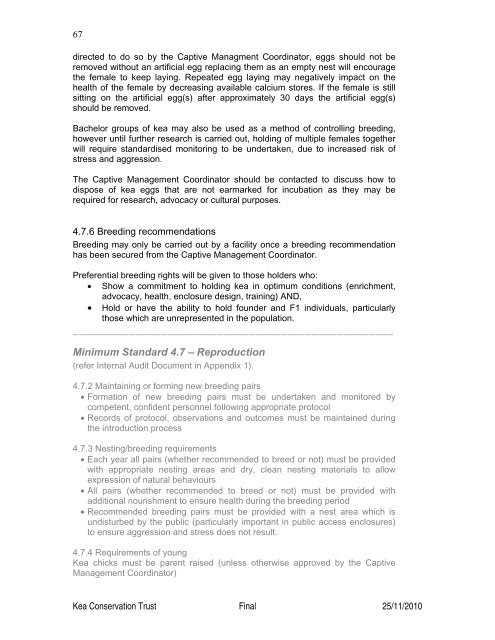(Nestor notabilis) Husbandry Manual - Kea Conservation Trust
(Nestor notabilis) Husbandry Manual - Kea Conservation Trust
(Nestor notabilis) Husbandry Manual - Kea Conservation Trust
Create successful ePaper yourself
Turn your PDF publications into a flip-book with our unique Google optimized e-Paper software.
67<br />
directed to do so by the Captive Managment Coordinator, eggs should not be<br />
removed without an artificial egg replacing them as an empty nest will encourage<br />
the female to keep laying. Repeated egg laying may negatively impact on the<br />
health of the female by decreasing available calcium stores. If the female is still<br />
sitting on the artificial egg(s) after approximately 30 days the artificial egg(s)<br />
should be removed.<br />
Bachelor groups of kea may also be used as a method of controlling breeding,<br />
however until further research is carried out, holding of multiple females together<br />
will require standardised monitoring to be undertaken, due to increased risk of<br />
stress and aggression.<br />
The Captive Management Coordinator should be contacted to discuss how to<br />
dispose of kea eggs that are not earmarked for incubation as they may be<br />
required for research, advocacy or cultural purposes.<br />
4.7.6 Breeding recommendations<br />
Breeding may only be carried out by a facility once a breeding recommendation<br />
has been secured from the Captive Management Coordinator.<br />
Preferential breeding rights will be given to those holders who:<br />
• Show a commitment to holding kea in optimum conditions (enrichment,<br />
advocacy, health, enclosure design, training) AND,<br />
• Hold or have the ability to hold founder and F1 individuals, particularly<br />
those which are unrepresented in the population.<br />
___________________________________________________<br />
Minimum Standard 4.7 – Reproduction<br />
(refer Internal Audit Document in Appendix 1).<br />
4.7.2 Maintaining or forming new breeding pairs<br />
• Formation of new breeding pairs must be undertaken and monitored by<br />
competent, confident personnel following appropriate protocol<br />
• Records of protocol, observations and outcomes must be maintained during<br />
the introduction process<br />
4.7.3 Nesting/breeding requirements<br />
• Each year all pairs (whether recommended to breed or not) must be provided<br />
with appropriate nesting areas and dry, clean nesting materials to allow<br />
expression of natural behaviours<br />
• All pairs (whether recommended to breed or not) must be provided with<br />
additional nourishment to ensure health during the breeding period<br />
• Recommended breeding pairs must be provided with a nest area which is<br />
undisturbed by the public (particularly important in public access enclosures)<br />
to ensure aggression and stress does not result.<br />
4.7.4 Requirements of young<br />
<strong>Kea</strong> chicks must be parent raised (unless otherwise approved by the Captive<br />
Management Coordinator)<br />
<strong>Kea</strong> <strong>Conservation</strong> <strong>Trust</strong> Final 25/11/2010












